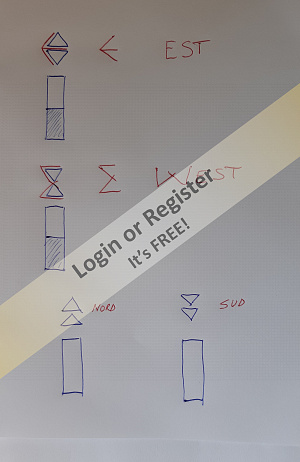Join Us On Social Media!
Pats QOD 18/08/25
6 Posts · 2 Followers · 3 Photos · 6 Likes
Began 4 months ago by
Follow This Thread
Not currently following
> Click to follow
> Click to follow
Latest Post 4 months ago by
( Newest Posts Shown First )
📝 Pats QOD 18/08/25
10 Views
Country: 🇮🇹 Italy
Online: 30 minutes ago
Online: 30 minutes ago
Great Pat, let's make your answers useful to everyone.
▲
⟩⟩
No likes yet
This member will receive 1 point
for every like received
This member will receive 1 point
for every like received
📝 Pats QOD 18/08/25
13 Views · 1 Like
Country: 🇬🇧 United Kingdom
Online: 1 hour ago
Online: 1 hour ago
📝 Pats QOD 18/08/25
9 Views · 1 Like
Country: 🇮🇹 Italy
Online: 30 minutes ago
Online: 30 minutes ago
Hi Pat, do you agree with this answer too?
▲
⟩⟩
SouthportPat
📝 Pats QOD 18/08/25
14 Views · 1 Like
Country: 🇮🇹 Italy
Online: 30 minutes ago
Online: 30 minutes ago
I.A.L.A.
It is the International Association of Lighthouse Authorities.
A system of daytime signals (using the colors and shapes of lighthouses, beacons, buoys, etc.) and nighttime signals using lights emitted by lanterns.
The system includes five types of signals.
1. Side signals.
2. Cardinal signals
3. Isolated danger signals
4. Safe water signals
5. Special signals
1. Side signals. As I already mentioned in the IA's QoD (message no. 3800 and no. 3804 from four months ago), this is the only signal that is not the same throughout the world.
In this case, the world is divided into two zones, A and B (zone A includes Europe, Africa, Oceania, and Asia except Japan, Korea, and the Philippines, while zone B includes the Americas, Japan, Korea, and the Philippines).
They indicate which side they should be left for navigation (for example, at the entrance to a port). They are either red or green. The red marker is a cylinder, while the green marker is a cone. When entering a port in Zone A, you must leave the red marker on your left and the green marker on your right. The opposite is true in Zone B.
Strange but true.
At night, the color is red or green.
Since there's no point in linking to the question of the day, given the large number of messages to scroll through, I'm posting the text here:
QoD message no. 3800 from four months ago.
"...I wrote: "Signals of this type are international and cannot be interpreted or mistaken".
I forgot to say something important. It is true that these rules are international and apply to everyone, however the world is divided into two parts A and B (only with regard to sidelights). The rules of part A differ from those of part B.
If you ask me what the reason is, well I don't know, but it is so.
Even more strange and apparently inexplicable (at least for me and for now) is the criterion for dividing these two areas."
2. Cardinal signals. They are placed on rocks, shoals, and other dangerous locations and indicate which cardinal direction (North, South, East, West) to pass to avoid the danger.
In this regard, in QoD messages no. 3746 and no. 3810 from four months ago, I suggested two simple methods for remembering daytime and nighttime signals without having to strain your memory.
Here is the text:
message no. 3746
"Hello everyone.
....
When I learned them, I used a simple method for cardinal signals: cones with opposite vertices form the letter E (i.e., East), while cones with joined vertices form the letter W (i.e., West). North is indicated by the cones pointing upward, and south by the cones pointing downward.
This is certainly not an isolated danger; these are not safe waters, much less a special signal."
Who remembers the clock trick I described in message 3810?
3. Isolated danger signals. These are placed on a limited-area danger entirely surrounded by navigable waters. During the day, beacons or buoys (red and black) with two superimposed black spheres. At night, a white light in groups of two lamps.
4. Safe water signals. They indicate a sea area free of dangers. During the day, buoys or beacons (red and white) with a red sphere on top. At night, a white light with a single flash or intermittent light. Other types of flashes, but rarer, are also omitted unless they are of particular interest to anyone.
5. Special signals. They indicate or delimit protected maritime areas, fish farms, work zones, mooring areas, training areas, etc. During the day, an all-yellow signal with a yellow St. Andrew's cross mainstay. At night, a yellow light with single flashes.


It is the International Association of Lighthouse Authorities.
A system of daytime signals (using the colors and shapes of lighthouses, beacons, buoys, etc.) and nighttime signals using lights emitted by lanterns.
The system includes five types of signals.
1. Side signals.
2. Cardinal signals
3. Isolated danger signals
4. Safe water signals
5. Special signals
1. Side signals. As I already mentioned in the IA's QoD (message no. 3800 and no. 3804 from four months ago), this is the only signal that is not the same throughout the world.
In this case, the world is divided into two zones, A and B (zone A includes Europe, Africa, Oceania, and Asia except Japan, Korea, and the Philippines, while zone B includes the Americas, Japan, Korea, and the Philippines).
They indicate which side they should be left for navigation (for example, at the entrance to a port). They are either red or green. The red marker is a cylinder, while the green marker is a cone. When entering a port in Zone A, you must leave the red marker on your left and the green marker on your right. The opposite is true in Zone B.
Strange but true.
At night, the color is red or green.
Since there's no point in linking to the question of the day, given the large number of messages to scroll through, I'm posting the text here:
QoD message no. 3800 from four months ago.
"...I wrote: "Signals of this type are international and cannot be interpreted or mistaken".
I forgot to say something important. It is true that these rules are international and apply to everyone, however the world is divided into two parts A and B (only with regard to sidelights). The rules of part A differ from those of part B.
If you ask me what the reason is, well I don't know, but it is so.
Even more strange and apparently inexplicable (at least for me and for now) is the criterion for dividing these two areas."
2. Cardinal signals. They are placed on rocks, shoals, and other dangerous locations and indicate which cardinal direction (North, South, East, West) to pass to avoid the danger.
In this regard, in QoD messages no. 3746 and no. 3810 from four months ago, I suggested two simple methods for remembering daytime and nighttime signals without having to strain your memory.
Here is the text:
message no. 3746
"Hello everyone.
....
When I learned them, I used a simple method for cardinal signals: cones with opposite vertices form the letter E (i.e., East), while cones with joined vertices form the letter W (i.e., West). North is indicated by the cones pointing upward, and south by the cones pointing downward.
This is certainly not an isolated danger; these are not safe waters, much less a special signal."
Who remembers the clock trick I described in message 3810?
3. Isolated danger signals. These are placed on a limited-area danger entirely surrounded by navigable waters. During the day, beacons or buoys (red and black) with two superimposed black spheres. At night, a white light in groups of two lamps.
4. Safe water signals. They indicate a sea area free of dangers. During the day, buoys or beacons (red and white) with a red sphere on top. At night, a white light with a single flash or intermittent light. Other types of flashes, but rarer, are also omitted unless they are of particular interest to anyone.
5. Special signals. They indicate or delimit protected maritime areas, fish farms, work zones, mooring areas, training areas, etc. During the day, an all-yellow signal with a yellow St. Andrew's cross mainstay. At night, a yellow light with single flashes.


▲
⟩⟩
SouthportPat
📝 Pats QOD 18/08/25
14 Views · 3 Likes
Country: 🇬🇧 United Kingdom
Online: 3 hours ago
Online: 3 hours ago
International Association of Marine Aids to Navigation and Lighthouse Authorities
Indicates safe water to north, south, east or west. Highlights dangers like rocks, shallows etc.
Indicates safe water to north, south, east or west. Highlights dangers like rocks, shallows etc.
▲
⟩⟩
SouthportPat
AlessandroSPQR
AustinG
📝 Pats QOD 18/08/25
16 Views
Country: 🇬🇧 United Kingdom
Online: 1 hour ago
Online: 1 hour ago
Hi Budding Navigators
1. In Marine Navigation what do in intials IALA stand for ?
2. What does a Cardinal Mark show ?
Good Luck
Pat
1. In Marine Navigation what do in intials IALA stand for ?
2. What does a Cardinal Mark show ?
Good Luck
Pat
▲
⟩⟩
No likes yet
This member will receive 1 point
for every like received
This member will receive 1 point
for every like received





 Commodore
Commodore United Kingdom
United Kingdom Fleet Admiral
Fleet Admiral Italy
Italy
 Captain
Captain












